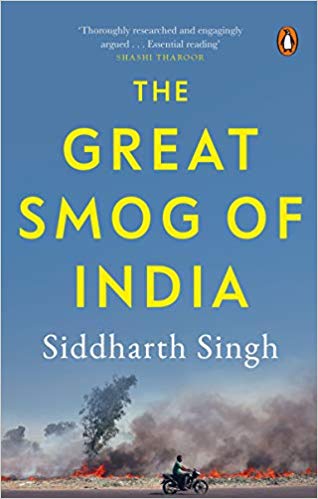Book Review | The Great Smog of India
Title: The Great Smog of India
Author: Siddharth Singh
Pages: 262
Price: INR 499
 Mid-October, I saw a series of tweets by Siddharth Singh talking about his upcoming book on air pollution in Delhi and made a mental note to look it up. Little did I know that it would soon make its way to me to read and review.
Mid-October, I saw a series of tweets by Siddharth Singh talking about his upcoming book on air pollution in Delhi and made a mental note to look it up. Little did I know that it would soon make its way to me to read and review.
The Great Smog of India by Siddharth Singh is a timely read on Delhi’s people, policies and pollution. For folks outside Delhi, the annual smog episodes in winter are mere headlines but this book brings into focus the challenges residents face on a daily basis.
It contextualizes the crisis through multiple lenses: historical, political and geographic. It also provides global references where cities have successfully tackled a similar situation.
Because I make it a point to always read the Acknowledgements first, I noticed that it was placed in the very beginning and not at the end, as I have come to expect it. Singh’s comprehensive network is a reflection of how well he is placed to explain this issue and elaborate on the numerous factors.
However, Singh takes his time and words to set the stage and present the problem. And the editor in me was itching to get hold of a red pen. Once he had introduced the problem, the writing flowed far smoother and it is evident how much he enjoyed writing them.
By comparing air pollution to terrorism, Singh equates the right to clean air with the right to liberty and safety. On p.34, he writes, “It can be argued that air pollution is one such form of unfreedom, one that takes away the opportunity from people to live a full life”.
For most of us who wonder why only Delhi is afflicted and not Bombay or Chennai, Singh explains in detail Delhi’s misfortune. This is a lesson I don’t remember reading in school.
Energizing India was a fascinating read on India’s energy grid. And How India Moves answered one question I’ve always had: The difference between a metro system and a suburban rail.
But the real eye-opener was the role of agriculture in air pollution, strange as it may sound. While I was familiar with the concept of stubble burning and the spoils of the Green Revolution, Singh highlights the not-so green side of the initiative. It’s a complex multi-state problem, which few in governance or the private sector wish to acknowledge or address, as amply discussed in The Administrative Tournament.
On p.193, Singh writes, “India’s fight against air pollution is therefore fragmented in several ways: the administration, ministries, monitoring agencies, expert committees, judiciary and even the response plans.”
What I missed in The Great Smog of India were vignettes and conversations. Singh presents numerous facts and figures, and most will tend to gloss over them. Maybe the same data could have been shared visually.
The lack of political intent is the best takeaway from this book. A serving bureaucrat beautifully sums this up in a quote on p.195. “Until the time someone loses an election due to air quality, don’t expect the issue to invite the political will to tackle this multi-state, multi-ministry issue.”

 Crazy Cat Lady Finds Love by Sudesna Ghosh is a fun read on cats, gal pals and contemporary relationships. Ghosh is a descriptive writer. And reading her words is like talking to an old friend. The prose is conversational and she crafts an easy to believe world with her gal pals, parents and cats.
Crazy Cat Lady Finds Love by Sudesna Ghosh is a fun read on cats, gal pals and contemporary relationships. Ghosh is a descriptive writer. And reading her words is like talking to an old friend. The prose is conversational and she crafts an easy to believe world with her gal pals, parents and cats. Love Curry by Pankaj Dubey is a tale of three flatmates in London; Rishi, an Indian; Ali, a Pakistani and Shehzad, a Bangladeshi. They lead vastly different lives but their similar backgrounds keep them intact and together.
Love Curry by Pankaj Dubey is a tale of three flatmates in London; Rishi, an Indian; Ali, a Pakistani and Shehzad, a Bangladeshi. They lead vastly different lives but their similar backgrounds keep them intact and together.